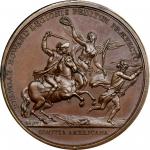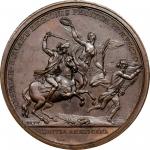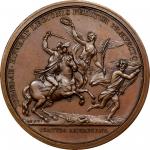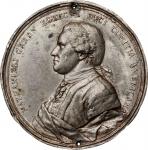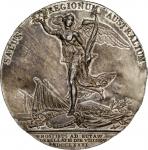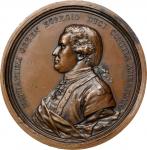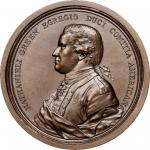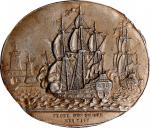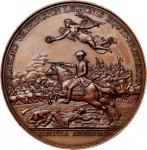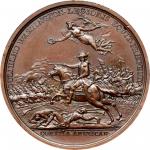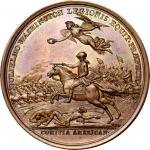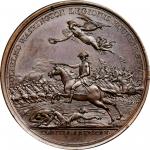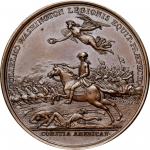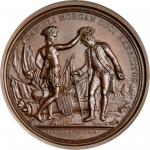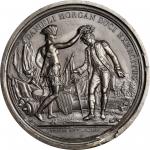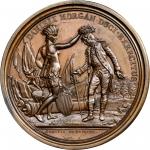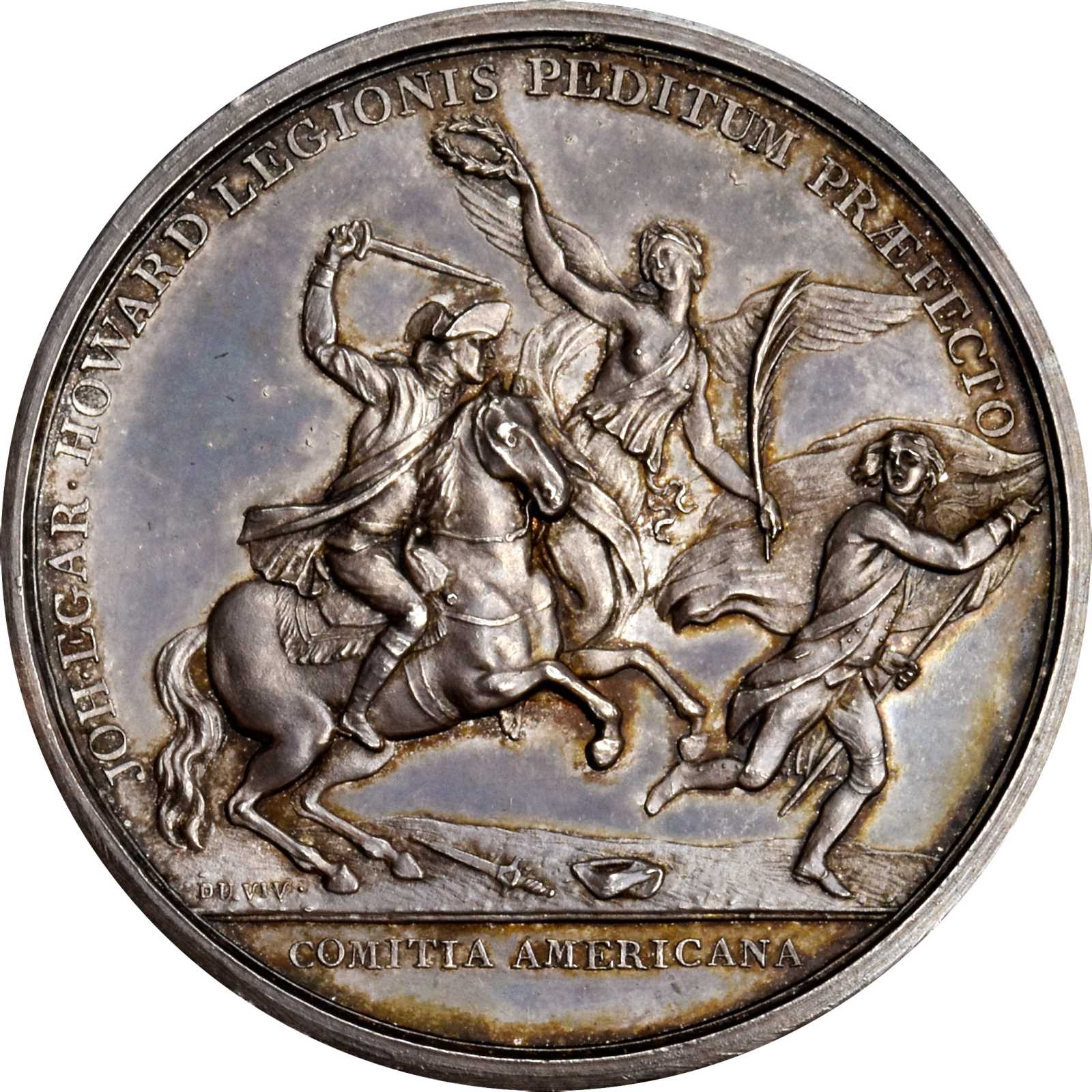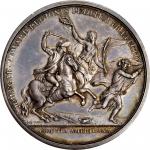1781 John Eager Howard at Cowpens medal. Betts-595. Silver. Original. Paris Mint. 46.1 mm, 708.0 grains. 3.4 - 3.6 mm thick. Choice Mint State.Plain concave edge, witness lines or collaring marks near 4:30 and 10:00 relative to the obverse. A beautiful example from the early die state, essentially identical to Washingtons own in the Massachusetts Historical Society. Deeply reflective fields, typical of Paris Mint strikes, show bright luster and an elegant blend of blue toning with gold and violet highlights over light silver gray surfaces. The strike is crisp and the state of preservation is excellent, uncommonly fine for a first generation silver Comitia Americana medal. Only trivial flaws are noted, like an infinitesimal rim tick above E of LEGIONIS, two parallel scratches well hidden within the central obverse design at Victorys forearm and the flag tip below, a scattering of insignificant lines and contact points. The designs show a bold showcase for DuViviers devices, with the successful rendering of Howards equestrian heroism taking center stage while the somewhat clumsily punched legends hug the periphery. The medal has been well struck, and care was taken in Paris to reduce a wire rim or "fin," leaving some faint file marks around the obverse as a result, seen around the rim from about 5:00 to 10:00. The eye appeal is superb, particularly for an early issue that was distributed to non-numismatists who tended to use less care to preserve these medals.<p>The fast changing spalling, or chipping, of this obverse die serves as a waymarker for the die states of this medal. This one is early, with a small break above E of PEDITUM, a smaller break above the left side of T in that word, and a hard-to-see break embedded in the wreath two leaves right of the ribbon atop the reverse. The specimen at MHS is only trivially earlier, if at all.<p>While the Ford sale estimated "there may be as few as 10 of these," we believe this medal is significantly rarer. The Adams and Bentley census accounted for six specimens, including those impounded in the Massachusetts Historical Society and Maryland Historical Society. Ford and Dreyfuss had original strikings in silver. Tony Lopez has reported a census of seven known, though one of those seven gives us pause and another has not been seen.<p>The historical record of sales of known silver specimens is thin. The Bushnell specimen in silver was unplated; it sold for $1.55 to "Ahlborn," presumably Boston dealer Henry rather than Swedish engraver Lea. Richard Winsors, sold by the Chapmans in 1895, may have been the Bushnell piece. It was likewise unplated and brought $2. The only other silver Howard the Chapmans - or any other 19th century American numismatic auction firm - ever sold was offered in S. Hudson Chapmans sale of June 1917. It brought $3. None of these were described as original or restrike. The piece in Tom Elders September 1938 sale, offered as lot 442, was described as an original in silver. We find no other American auction offering until Fords piece sold in 2006. Acquired by Ford from Paris dealer Jean Vinchon, it was reoffered in our Philadelphia Americana sale of September 2009.<p>Two silver Howards were included in the Adams Collection; only one is being offered. The other piece was hallmarked with matte surfaces, square edges that showed significant post-production filing, a slightly smaller diameter, and some loss of detail versus the piece here offered, suggesting enough red flags of a potential cast to give us pause. Fifteen years ago, your cataloger was dispatched to the Maryland Historical Society to view their specimen, said to be Howards own. Your cataloger was shown a piece that he concluded at the time was a cast (though, without the benefit of a photographic memory or actual photographs, I couldnt say for sure that the piece was of a similar character to the second Adams piece). Another researcher later visited the Maryland Historical Society and was shown a piece that he wholeheartedly endorsed as an authentic striking; the institution had shown two different specimens to two different people a few years apart. This situation is described in Adams and Bentleys note 241 and in Tony Lopezs article for the September 2008 <em>MCA Advisory</em> on the Howard medal. The second Adams piece is listed in Adams and Bentley as Census #4, but the diameter and weight given for #4 matches the Dreyfuss specimen. The metrological data for the second Adams specimen match the listing for #5.<p>While these dies remained in use in Paris for the whole of the 19th century, plain edge silver originals are more elusive than is typically believed. Even silver restrikes are rare. A specimen like this one, struck from an early die state that suggests it was produced before Jefferson left Paris, is a rarity of particular interest.<p><strong>The Battle of Cowpens</strong><p><strong>The Action:</strong><p>The day after Christmas 1779, Sir Henry Clinton and General Charles Cornwallis left British-occupied New York with more than 8,000 men. Their destination was Charleston, South Carolina, and upon their arrival the focus of the Revolutionary War became the struggle to win the hearts, minds, and battlefields of the Carolinas. Clinton and Cornwallis laid siege to Charleston beginning in April 1780, and the following month they controlled the city. Their army made its way to the middle of South Carolina and encamped near the town of Camden, where Horatio Gates, the newly appointed commander of the Southern Department, encountered Cornwallis force in August 1780. Gates was soundly defeated, his force decimated, his reputation essentially destroyed. Cornwallis and his forces, including reviled Banastre Tarleton, captured the tiny hamlet of Charlotte soon thereafter, then made their way back to winter camp in central South Carolina, in the town of Winnsborough.<p>Following Gates relief from command, General George Washington dispatched a member of his "military family" to the Southern Department: Nathanael Greene. Greenes strategy revolved not around direct large-scale confrontation, but fleeting contact and costly chases, meant to expose the British and their Loyalist partisans to guerrilla attacks and keep their divided forces far from supply lines. The October 1780 American victory at Kings Mountain, along the North Carolina / South Carolina border, bolstered the Patriot cause in the Upcountry. Greene had made his winter camp in Cheraw, in the eastern Pee Dee region of South Carolina, but a portion of his troops under General Daniel Morgan continued to move through the backcountry. Cornwallis dispatched Tarleton to give chase with a force of just over 1,000 men, mostly British regulars.<p>Morgan chose the place he would permit Tarleton to meet his men: at the Cowpens, a pasture near the North Carolina state line close to modern Spartanburg. Morgan, known for his team of crack riflemen, decided to capitalize upon the British stereotype that American militiamen would quickly retreat. He ordered his militia to do just that, then move to the rear, reform, and wait for Continental regulars to break through the British line.<p>Holding the rear high ground, his plan worked like a charm, finished off by an infantry line held together by Col. John Eager Howards leadership and a cavalry charge led by Col. William Washington as the denouement. Morgan described his defeat of Tarleton as "a devil of a whipping." Congress agreed, and selected him to receive a gold medal, while both Howard and Washington were awarded silver medals. Only Cowpens and the 1779 reduction of Stony Point were recognized with three medals. <p>After the victory at Cowpens, Greene and Morgan reunited and moved north, meeting Cornwallis at Guilford Court House in March 1781. With his force badly weakened after the battle, Cornwallis marched for Wilmington, on the North Carolina coast, to regroup. His next, and final, stop would be Yorktown.<p><strong>The Resolution:</strong><p><em>The United States in Congress assembled, considering it as a tribute due to distinguished merit to give a public approbation of the conduct of Brigadier General Morgan, and of the officers and men under his command, on the 17th day of January last; when with eighty cavalry, and two hundred and thirty-seven infantry of the troops of the United States, and five hundred and fifty-three militia from the States of Virginia, North Carolina, South Carolina, and Georgia, he obtained a complete and important victory over a select and well appointed detachment of more than eleven hundred British troops, commanded by Lieutenant Colonel Tarleton; do therefore resolve,</em><p><em>That the thanks of the United States in Congress assembled, be given to Brigadier General Morgan, and the officers and men under his command, for their fortitude and good conduct, displayed in the action at the Cowpens, in the State of South Carolina, on the 17th of January last:</em><p><em>That a Medal of Gold be presented to Brigr Genl Morgan representing on one side the action aforesaid particularising his numbers, the numbers of the enemy, the numbers of killed, wounded and prisoners and his trophies with the inscription patria virtusis [undecipherable], and on the other side his bust with his name and this inscription: Ipse agmen the figure of the General on horseback leading on his troops in pursuit of the flying enemy, with this motto in the Exergue Fortus Fortuna Juvat Virtus Unita Valet.</em><p><p><em>That a medal of gold be presented to Brigadier General Morgan, and a medal of silver to Lieutenant Colonel W. Washington, of the cavalry, and one of silver to Lieutenant Colonel Howard, of the infantry of the United States; severally with emblems and mottos descriptive of the conduct of those officers respectively on that memorable day:</em><p><em>That a sword be presented to Colonel Pickens, of the militia, in testimony of his spirited decisive and magnanimous conduct in the action before mentioned:</em><p><em>Resolved, that a sword be presented to Lieutenant Colonel Howard of the infantry, and one also to Lieutenant Colonel Washington of Recommitted. the Cavalry of the federal army each, that their names may be transmitted honourably to posterity renowned for public virtue and as testimonies of the high sense entertained by Congress of their martial accomplishments.</em><p><em>That Major Edward Giles, aid-de-camp of Brigadier General Morgan, have the brevet commission of a major; and that Baron de Glasbeech, who served with Brigadier General Morgan as a volunteer, have the brevet commission of captain in the army of the United States; in consideration of their merit and services.</em><p><em>Ordered, That the commanding officer in the southern department, communicate these resolutions in general orders.</em><p><em>- Continental Congress Resolution of March 9, 1781</em><p><strong>John Eager Howard at Cowpens</strong><p><strong>The Acquisition: </strong><p>Along with the William Washington medal for Cowpens, and General George Washingtons medal for the action at Dorchester Heights, this was among the very last batch of Comitia Americana medals completed. David Humphreys handed the Comitia Americana project off to Thomas Jefferson in an April 4, 1786 letter: "I have made no contracts for the other four, viz. for Genl. Washingtons on the evacuation of Boston, for Morgan, Washington and Howard on the affair of the Cowpens, because the designs for them have not been in readiness for execution until the present time." Jefferson hired Pierre-Simon-Benjamin Duvivier to do all three of those mentioned; the fourth commission, for the Daniel Morgan medal, went to Augustin Dupre, who Jefferson preferred as the superior artist. Jeffersons initial contact with Duvivier appears to have come no earlier than the end of 1788, more than two and a half years after Humphreys departure. Duvivier wrote to Jefferson four times in 1789: on January 5, February 23, April 11, and June 7. None of the letters have survived. But when Jefferson boarded a ship bound for Norfolk, Virginia in the fall of 1789, he carried with him all of Duviviers works, including the silver medal for Howard.<p><strong>The Presentation:</strong><p>Jefferson turned Howards medal over to Washington in March 1790, along with Washingtons set of silver Comitia Americana medals and the unique Washington Before Boston medal in gold, as well as other medals bound for their Congressionally authorized recipients. Washington tucked Howards silver medal into a letter dated March 25, 1790 and dispatched it by mail.<p><em>New York March 25th 1790</em><p><em>Sir,</em><p><em>You will receive with this a Medal struck by order of the late Congress in commemoration of your much approved conduct in the battle of the Cowpens-and presented to you as a mark of the high sense which your Country entertains of your services on that occasion.</em><p><em>This Medal was put into my hands by Mr Jefferson; and it is with singular pleasure that I now transmit it to you.</em><p><em>I am, with very great esteem, </em><p><em>Your Excellencys most Obedt Servt</em><p><em>Go: Washington</em><p>Howard responded with the enthusiasm his military bearing could permit on June 21, 1790, from his home in Annapolis. <p><em>Sir,</em><p><em>I had the honor to receive your Excellencys letter of the 25th march with a medal ordered to be struck by the late Congress. my only object in the late war was to render any service in my power in the common cause, and my only hope of reward was that my conduct might meet the approbation of my Country; the obliging manner in which you are pleased to communicate this mark of approbation which my Country has expressed of my conduct, affords me the highest satisfaction.</em><p><strong>The John Eager Howard at Cowpens Medal:</strong><p><strong>Obverse:</strong> As Col. Howard charges right with sword drawn, Victory reaches up to crown him with a laurel with her right hand and holds up a palm branch with her left. A British soldier carries his flag and runs off to the right, leaving his sword and tricorn hat behind. JOH EGAR HOWARD LEGIONIS PEDITUM PRAEFECTO means "John Eager Howard, who commanded the cavalry regiment." COMITIA AMERICANA is seen in the exergue below. Howards actual middle name is Eager, not Egar, as spelled on the medal. The original draft of the Congressional resolution called for the obverse to show "the charge ordered and conducted by him in that critical moment when the enemy were thrown into disorder by the fire from the line under his Command, and the latter instantly charging, victory hovering over both Armies and dropping a branch of Laurel to be instantly snatched by Lt. Colonel Howard, with this Motto- occasione oerupta."<p><strong>Reverse:</strong> An unending wreath of laurel, festooned with internal ribbons at top and bottom, surrounds a seven-line legend: QUOD IN NUTANTEM HOSTIUM ACIEM SUBITO IRRUENS PRAECLARUM BELLICAE VIRTUTIS SPECIMEN DEDIT IN PUGNA AD COWPENS XVII JAN. MDCCLXXXI (By his impromptu charge at the enemys wavering line, he showed an example of bravery in battle at Cowpens, January 17, 1781). This is an improvement upon Congress proposed inscription: "In honor of the prompt and decisive conduct and gallantry of Lt Col Howard in the action of the victory obtained at the Cowpens 17th of January 1781."<p><p><p>From the John W. Adams Collection. Acquired from Dr. Paul Patterson.

